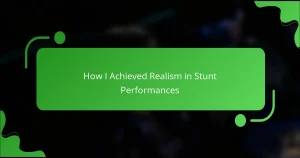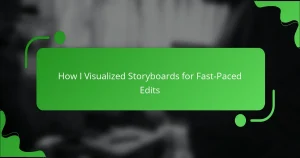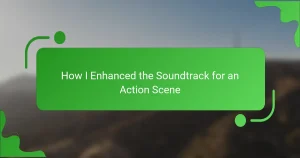Key takeaways
- Action short films rely on clear objectives, creative conflict, pacing, visual storytelling, and emotional stakes to engage audiences.
- Building suspense involves uncertainty, careful pacing, and effective sound design to amplify emotional impact.
- Incorporating unexpected plot twists and character development keeps viewers invested and enhances narrative depth.
- Personal storytelling methods like flashbacks and emotional scenes deepen audience connection and create immersive experiences.
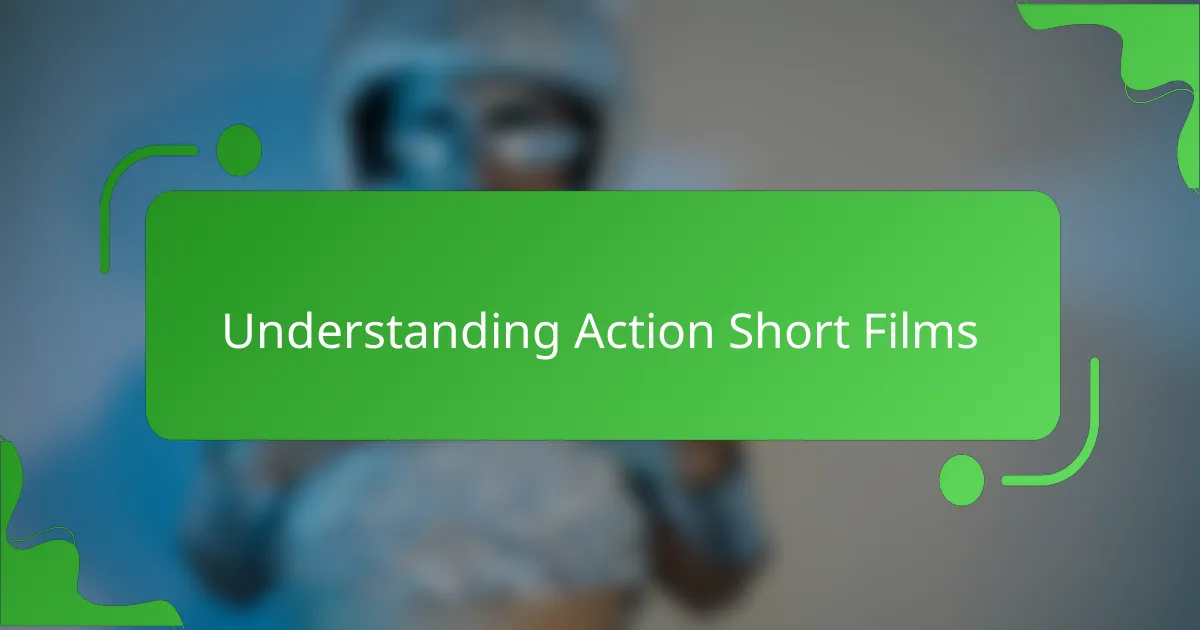
Understanding action short films
Action short films are a fascinating genre that distills the thrill of action-packed storytelling into a compact format. Through my experience, I’ve found that these films often rely on precise pacing and visual storytelling to maintain the viewer’s adrenaline rush. It’s incredible how a well-timed fight scene or a tension-building chase can leave audiences on the edge of their seats.
In my journey of creating action short films, I learned that understanding the core elements that drive tension is crucial. Here are some key aspects I focus on:
- Clear Objectives: Characters need clear goals, driving the narrative forward.
- Creative Use of Conflict: Introducing obstacles keeps the audience engaged.
- Pacing and Timing: Quick cuts and unexpected pauses can enhance suspense.
- Visual Storytelling: Brilliant cinematography can evoke emotions and tension without dialogue.
- Emotional Stakes: Relatable characters with personal stakes resonate with viewers.
By incorporating these elements, I strive to captivate my audience while keeping them immersed in the experience of the story.
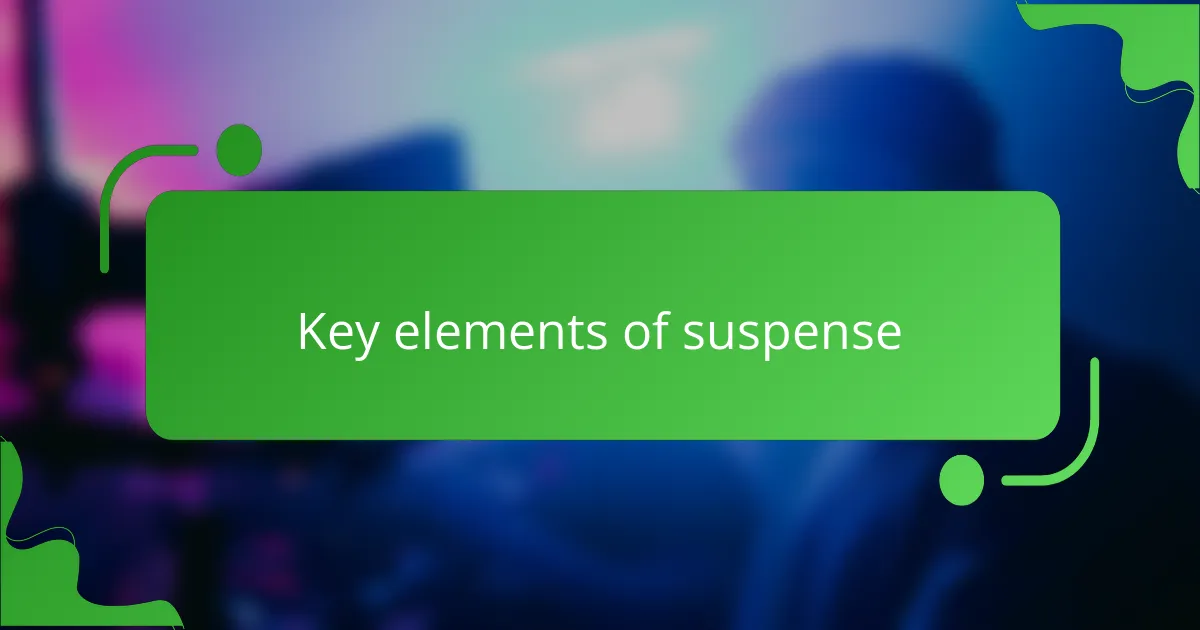
Key elements of suspense
To build suspense effectively, it’s crucial to create a sense of uncertainty. I remember while working on my own short films, I’d often leave crucial information just out of reach, compelling the audience to question what would happen next. This emotional investment keeps viewers on the edge of their seats.
Another key element is pacing. Too slow, and you risk losing the audience’s attention; too fast, and the tension dissipates. In one scene I crafted, I deliberately slowed down the action just before a climax, allowing every heartbeat to resonate, which heightened anticipation.
Lastly, the power of sound cannot be overlooked. I’ve found that the right music or sound effects can dramatically enhance the emotional weight of a scene. For instance, using an eerie soundtrack or sudden silence can effectively amplify moments of tension, drawing viewers deeper into the experience.
| Element | Description |
|---|---|
| Uncertainty | Keeping key information hidden to engage the audience’s curiosity. |
| Pacing | Balancing the speed of the plot to maintain tension and engagement. |
| Sound Design | Utilizing music and sound effects to heighten emotional resonance. |
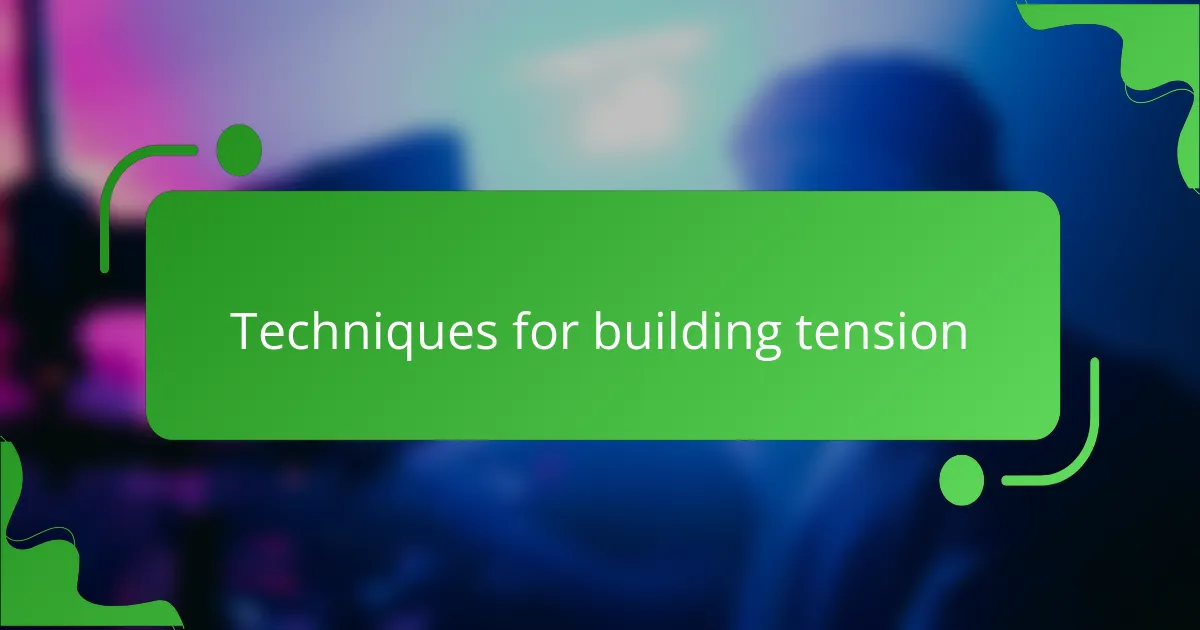
Techniques for building tension
Creating tension in action short films often boils down to establishing clear stakes. I remember a particular scene where the protagonist faced an impossible choice: save a loved one or complete the mission. By making the stakes personal, I found that audiences become emotionally invested, wondering what decision will be made and feeling the weight of that choice.
Another technique I’ve employed is introducing unexpected twists that catch viewers off guard. In one of my projects, just when the audience thought the hero was about to succeed, a hidden adversary emerged, shifting the dynamics entirely. I’ve learned that the element of surprise not only maintains suspense but also stimulates conversations among viewers long after the credits roll.
Finally, the use of visual motifs can significantly enhance tension. I once crafted a sequence where the same object—a ticking clock—appeared throughout various scenes. This subtle reminder of impending doom kept viewers attuned to the urgency. It’s remarkable how such a simple device can pull audiences deeper into the narrative, constantly reminding them that time is running out. Don’t you find that small details can create giant ripples in storytelling?
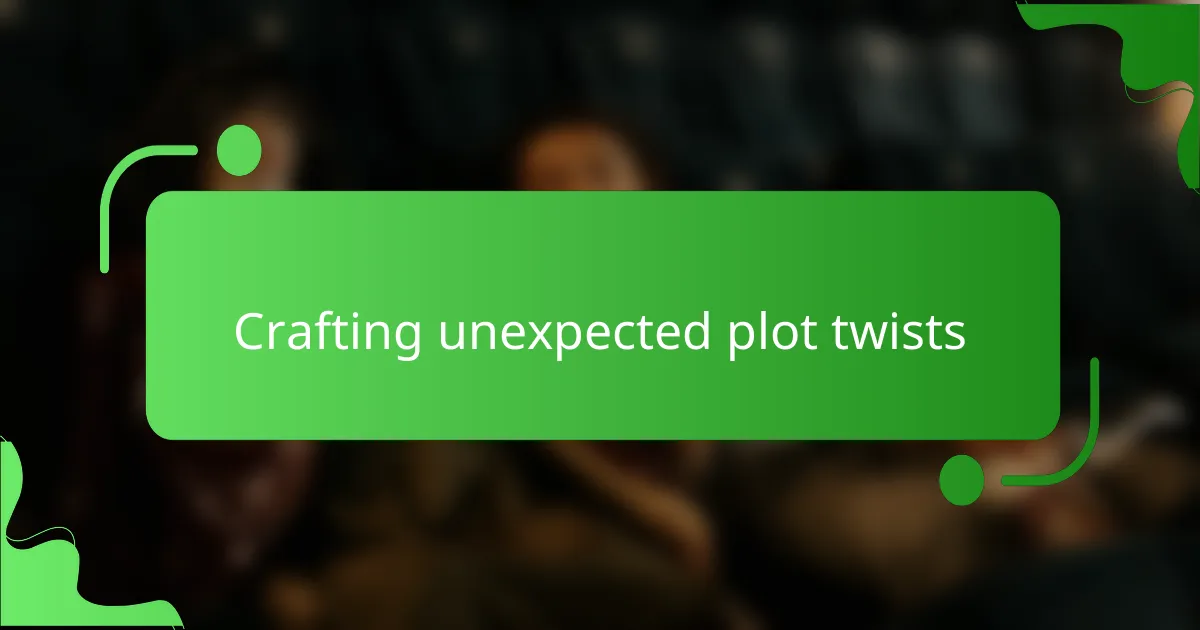
Crafting unexpected plot twists
Crafting unexpected plot twists is essential to keeping your audience on the edge of their seats. In my experience, I’ve found that the most effective twists are rooted in subtle foreshadowing. While working on my own short film, I introduced small hints that seemed innocuous at first. This provided a rush of realization for viewers when the twist hit, connecting all the dots in a way they didn’t foresee.
When planning these twists, I like to think about the emotional journey of my characters. How can I misdirect the audience while still honoring the storyline? I remember a moment when my character’s dialogue had seemingly no significant weight, only for it to unveil a critical backstory later on. This surprise not only shocked the audience but also added depth to the plot, making the twist feel earned rather than forced.
- Use character development to mislead viewers while keeping their backstories relevant.
- Introduce minor details that take on new significance later in the story.
- Create a believable setup that leads the audience to form assumptions, then turn those assumptions on their head.
- Ensure that your twist aligns with the overall theme of the film to maintain coherence.
- Test your twist with others to gauge their reactions and adjust accordingly, ensuring it’s genuinely unexpected.
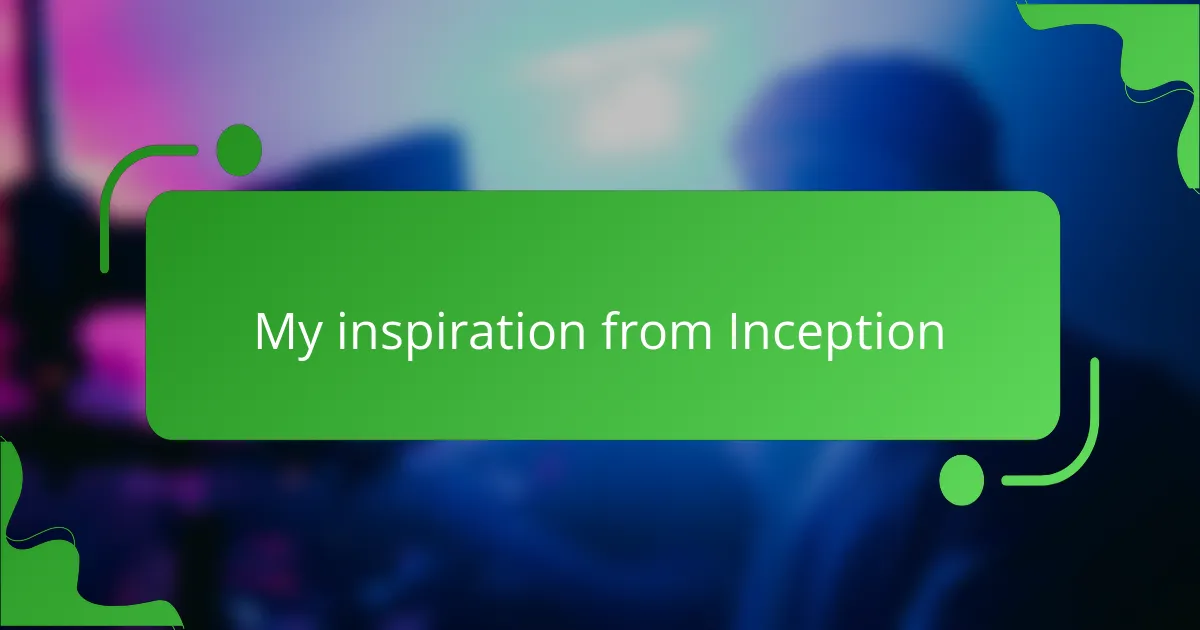
My inspiration from Inception
I’ve always admired how “Inception” intricately weaves its narrative layers, sparking my desire to create suspense through complex storytelling. Each time I watch it, I’m struck by how the dream-within-a-dream concept heightens tension. I have applied similar multi-layered approaches in my films, crafting narratives that encourage audiences to think deeply and stay engaged until the very last moment.
One memorable moment for me was when I experimented with non-linear storytelling in my own project. Just like in “Inception,” I found that jumping between timelines not only builds suspense but also creates an unpredictable rhythm that keeps viewers guessing. I remember the gasps in the audience when they realized how past actions influenced present outcomes—it felt exhilarating to watch their minds piece the puzzle together.
Another standout element of “Inception” is the emotional stakes paired with its labyrinthine plot. I’ve taken to heart the importance of grounding high-stakes scenarios in character-driven narratives. In one of my short films, I placed my protagonist in a life-altering decision, similar to Cobb’s journey, forcing the audience to empathize with their internal struggle. Have you ever noticed how emotional connections can magnify tension? That’s what I strive for in every frame.
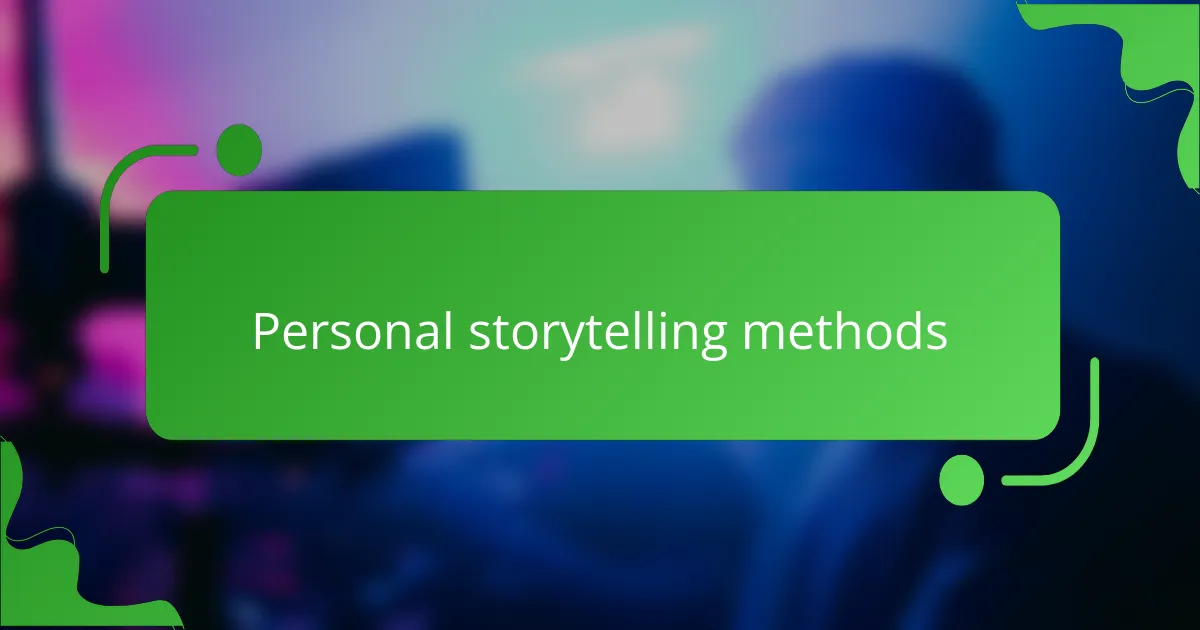
Personal storytelling methods
When it comes to personal storytelling methods in action short films, I find that layering different narratives can create an incredible sense of suspense. For instance, in one of my projects, I interwove the protagonist’s past experiences with the present conflict, allowing the audience to piece together the mystery as the tension heightened. This technique not only deepened the character’s motivations but also made viewers emotionally invested in the unfolding action.
A few methods that have worked well for me include:
- Flashbacks: Using brief, impactful flashbacks to reveal vital character backstory.
- Pacing: Manipulating pacing to build anticipation; slow moments can feel heavy with suspense before a quick burst of action.
- Unreliable Narrator: Employing a narrator whose perspective leads to twists, which keeps the audience second-guessing what’s real.
- Visual Foreshadowing: Incorporating subtle visual clues that hint at future events creates a deeper sense of suspense.
- Emotionally Charged Scenes: Focusing on emotional stakes, such as a character’s fear of loss or desperation, engages the audience’s empathy and heightens their suspense.
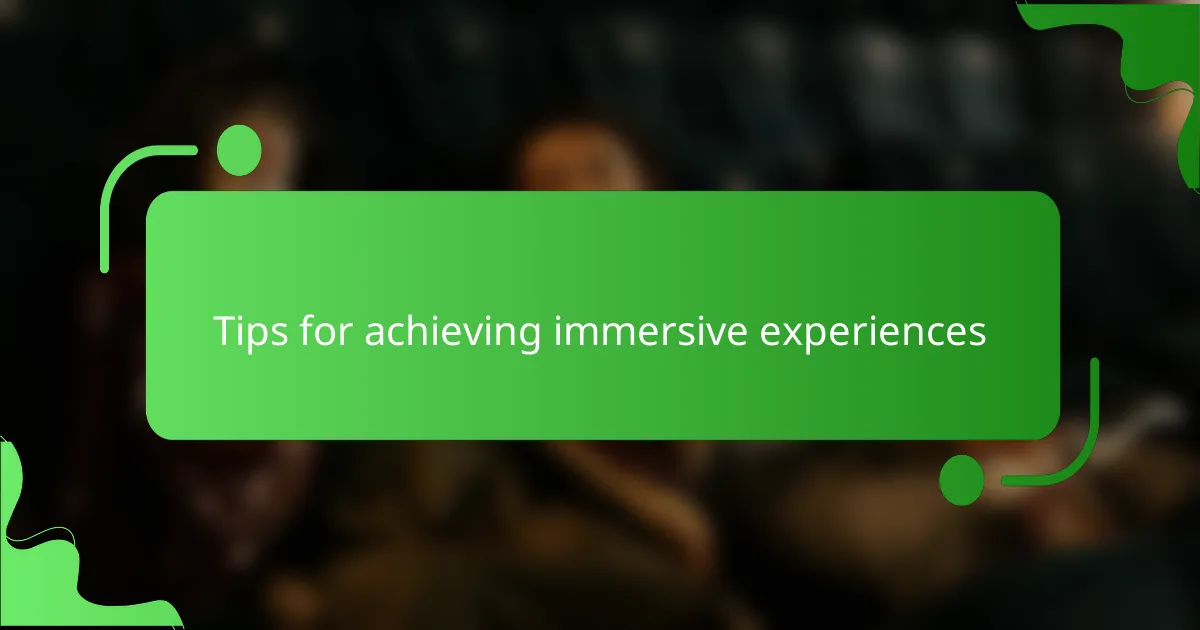
Tips for achieving immersive experiences
Creating an immersive experience in action short films is all about engaging the audience’s emotions and senses. I remember working on a short film where I used sound design strategically—muffled heartbeats during tense scenes drew the audience in, making them feel the character’s anxiety firsthand. The little things, like incorporating ambient sounds and precise editing, elevate the tension and keep viewers on the edge of their seats.
To achieve a truly immersive experience, consider these tips:
- Utilize ambient soundscapes to enhance the emotional atmosphere.
- Experiment with lighting; shadows can create an unsettling mood.
- Vary camera angles to provide different perspectives and maintain visual interest.
- Use pacing intentionally; slow-motion can heighten suspense during critical moments.
- Incorporate visual motifs throughout the film to create thematic continuity.
- Engage with your audience’s emotions; let them connect with the characters’ struggles.
These elements combined can truly transport your audience into the world of your film.
